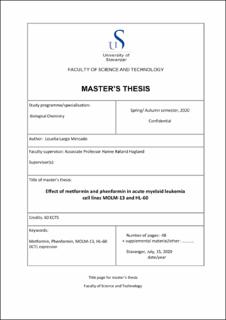| dc.contributor.advisor | Hagland, Hanna Røland | |
| dc.contributor.author | Mercado, Louelia | |
| dc.date.accessioned | 2020-09-29T08:14:36Z | |
| dc.date.available | 2020-09-29T08:14:36Z | |
| dc.date.issued | 2020-07 | |
| dc.identifier.uri | https://hdl.handle.net/11250/2680149 | |
| dc.description | Master's thesis in Biological chemistry | en_US |
| dc.description.abstract | Cancer is a large group of diseases and a second leading cause of death globally with an estimated 9.6 million death in 2018 according to World Health Organization (WHO). It is an abnormal and uncontrollably growth of cells that go beyond their boundaries and eventually invade and spread to the other part of the body. Acute myeloid leukemia (AML) is a type of blood cancer that is most common in adults. It is an abnormal differentiation and proliferation of myeloid precursor cells. Mutational complexity of AML is a challenge for proper diagnosis and a barrier for effective treatment strategy. Alternative drug strategies are continuously being tested and amongst them Metformin, the most prescribed and well tolerated anti-diabetic drug, have shown to have a potential as anti-cancer agent. Phenformin, a more potent derivative of Metformin is also interesting, but have shown to cause severe lactic acidosis in patients and has therefore been pulled-out as an alternative drug from the market. Numerous studies of metformin elucidating its effect point out that the metformin seems to be acting at multiple sites, however the import of the drug into cells is primarily facilitated through the Organic cation transporter 1 (OCT1) receptor. Thus, expression of the receptor would play an important role in the cell response to metformin or phenformin. This project had therefore the aim to assess the effect of metformin/phenformin treatment on two different AML cell lines, MOLM-13 and HL-60, and further examine the OCT1 expression of each cell line under the influence of metformin and phenformin treatment over time.
Our results showed that metformin and phenformin effects is dose- and time exposure dependent and their potency and efficacy varied in the two cell lines. MOLM-13 was observed to be more sensitive compared to HL-60 in both drug treatments. OCT1 expression in MOLM-13 was upregulated by metformin and phenformin treatments after over time, while in HL-60 it was downregulated with both treatments, but more so in phenformin treatment. | en_US |
| dc.language.iso | eng | en_US |
| dc.publisher | University of Stavanger, Norway | en_US |
| dc.relation.ispartofseries | Masteroppgave/UIS-TN-IKBM/2020; | |
| dc.subject | biologisk kjemi | en_US |
| dc.subject | metformin | en_US |
| dc.subject | leukemi | en_US |
| dc.subject | blodkreft | en_US |
| dc.title | Effect of metformin and phenformin in acute myeloid leukemia cell lines MOLM-13 and HL-60 | en_US |
| dc.type | Master thesis | en_US |
| dc.subject.nsi | VDP::Matematikk og Naturvitenskap: 400::Basale biofag: 470::Biokjemi: 476 | en_US |
| dc.source.pagenumber | 48 | en_US |
